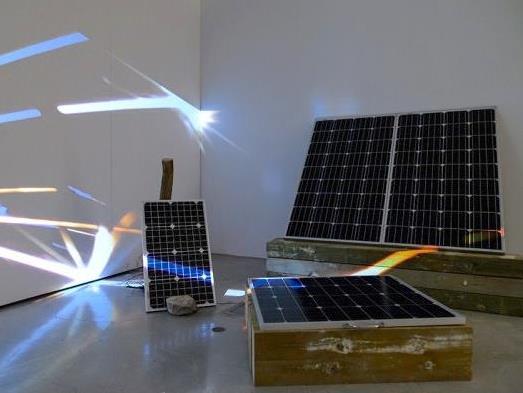Peter Blamey, Shelter Fallout/Spark Harvest, 2017. Installation view, Sounding the Future, UTS Gallery, 2017.
Sound is the vibration of matter, a combination of potential and kinetic energy. It also has potential in a different sense in the exhibition of Sounding the Future. Sound may be one of the earliest forms of expression, but in this exhibition it presents the possibilities of the future. We are not just viewers but also listeners of the exhibition at UTS Gallery, as we oscillate between the present and the future, humanity and technology, hope and futility.
Equally impressive and immersive, Gail Priest’s Sounding the Future places us in the driver’s seat as we enter the narrative of the future. Weaving sound, hypertext visuals, and science fiction, we direct a trackpad to explore three paths: future human, future city, and future citing. 50 possible audio-visual tracks combine to tell a story where the lines between technology and biology have blurred, where cities are tuned to sound and commotion, where ‘ficto-critical’ forms are the new expression.
The installation is tinged with possibility and choice, yet presents a future that is inevitable. Beautiful poetic prose is read by a cold robotic voice—the voice of a future human: “The city hums, more felt than heard. The city creaks and shrieks. The city pings and zings and shivers in endless iterations, only the algorithm knows.”
In 101500 years from now, stars will transform into iron before going supernova. As we enter the stark, white room curtained off from the rest of the exhibition, Iron Star by Pia van Gelder and Tom Smith present us with this iron future. A hypnotic tapping fills the room.
Two images are projected side-by-side; on the left, undulating dark textures—the final state of the universe devoid of human life. We hear a wave of white noise followed by ominous melody. On the right, repeated objects and symbols of iron. Between sounds and images, we travel between the furthest future and our present. An animalistic siren echoes. The room pulses but it’s not to the beat of a human heart, but rather an iron one.
Swept up in Shelter Fallout/Spark Harvest, we watch sparks like streaks of lightning dance on solar panels. But the panels are veiled in darkness and the sound that follows is not the expected thunder, but electronic bleeps and buzzes. Both the visual and audio components of this installation present the contrasting notions of nature and technology; a primitive technology.
The panels are a source of natural energy populating an unforgiving apocalyptic wasteland. As stated by the artist, Peter Blamey, it “considers the possibilities for energy harvesting in the face of catastrophic events, exploring hope, fatalism and futility…”
We are pulled back to the present in Mettāmatics 1 & 2 as we don headphones and clip a pulse sensor to our finger. We take a moment to exhale. Sitting in front of a blank wall featuring a green circle, we are left with nothing to focus on but ourselves. Soon we start to hear the soft pulses of our own heart. Coloured by our breath and emotion, the tone of our pulse changes as we are instructed to think of people, places, kindness, and hesitation.
At the adjacent station (Mettāmatics 2), layers of sound are also mixed on top of our heart rate, creating an individual symphony. The artist, George Poonkhin Khut, makes us mindful of our emotions and by listening, we are then able to look inwards.
Now, distant, afterward. Sound does not need to be experienced to exist, and it will prevail long after humanity. Sounding the Future blends imagination and observation, presenting us with the soundscape of the future while calling into question humanity’s role within this dark narrative.
The exhibition reminds us to listen, to feel. It moves us, shakes us, foretells an existence where sound doesn’t just have potential, it is powerful.
This essay was produced as part of the UTS Gallery Student Writing Program.
Sounding the Future is on display at UTS Gallery from 1 August – 22 September 2017.
The exhibition includes work by Peter Blamey, George Poonkhin Khut, Gail Priest, Pia van Gelder & Tom Smith, and is curated by Gail Priest.





